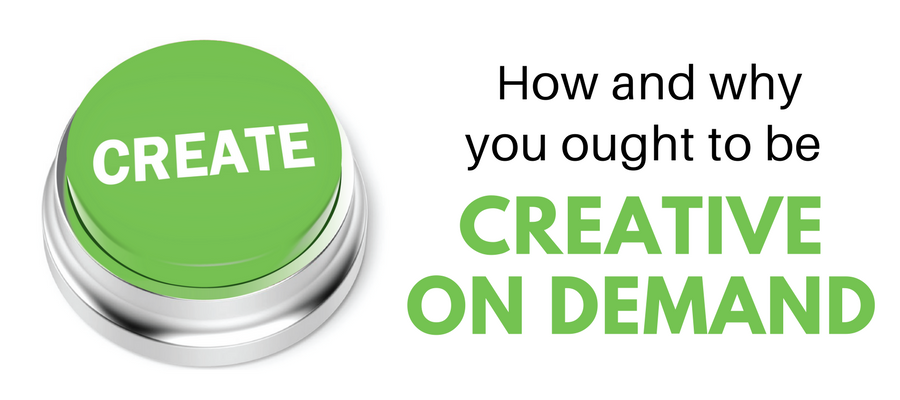Contrary to popular belief, creativity is NOT an innate ability – it’s actually a skill that can be cultivated and developed. With the right tools and mindset, you CAN be creative on demand. This article explores why you should care about this mindset, and then outlines some steps you can take to activate it.
Why be creative on demand?
Today, creativity and creative problem-solving skills are more important to organizations than ever. But for many people, the ability to BE creative is a fleeting thing. Their muse ebbs and flows mysteriously – and rarely shows up while they’re churning out work in the cubicle farm. Most people don’t realize that you can use a mindset shift, plus a selection of tools and techniques that can enable you to summon your creative muse on demand – any time, anywhere. I’ve been doing it for years.
Cultivating this skills can easily transform YOUR work and life. Imagine yourself enjoying these benefits:
Creativity on demand – for your own good
- You’ll become a linchpin, indispensable to your organization
- You’ll have a system to to tackle challenges and opportunities when they arise, in unique ways – a perfect way to differentiate yourself
- You’ll increase your job security by adding much more value than it costs to employ you
- You’ll know how to overcome creative blocks when you’re brainstorming or working on a project
- You’ll demonstrate an eagerness to grow and expand your role, making you much more promotable
- You’ll increase your personal satisfaction by bringing a broader approach and outlook to your work
- You’ll be able to quickly change, adapt and grow, no matter what circumstances you face – it’ll be part of your DNA!
Creativity on demand – for the good of your organization
- You’ll help your organization remain competitive and vital by imagining possible futures for it
- You’ll be able to offer new solutions for difficult problems that have been facing the business
- You’ll know how to uncover valuable new opportunities that can drive growth
In short, if you could be creative on demand, it would add so much juice to your life that you’d wonder how you got along without it!
How to be creative on demand
Develop an “insight outlook”
This is the art of looking more deeply at everything you experience with an open, inquisitive spirit. Creative people are intensely observant, paying careful attention to everything they think and hear. They realize that their environments – the people they talk to, the places they go, the things they read or hear on the radio or TV – can lead their thinking in fresh, exciting directions, which can lead to new ideas and opportunities. Learn to trust your gut instincts.
Keep creative problem-solving techniques at your fingertips
Maintain notes in Evernote that contain creative thinking and problem-solving techniques. Place them all in a single folder or tag them so that you can access them any time, anywhere.
Maintain “swipe files” for inspiration
I have them set up for creative headlines, metaphors, creative questions and more. You want something that you can open at any time, skim, and look for ideas and approaches you can use. Become a relentless collector of elements that inspire you.
Surround yourself with creative stimuli
Read widely. Listen to podcasts that challenge your thinking. Read books that are a bit outside of your comfort zone. Travel to someplace new, and drink in its sights, sounds and experiences. All of this stimuli becomes part of the “raw material pile” of your subconscious mind – the source of creative inspirations. In Evernote, capture your thoughts as you experience new stimuli. Dictate your thoughts and ideas into the Evernote app on yur mobile device. Take a picture and attach a note to it – one that briefly reminds you of its significance.
How do you know which of your ideas are the best?
Develop a structured approach to evaluating your ideas, so you can consistently identify those with the biggest potential value. One way to do that is to set up criteria and a rating scale that makes sense for you. Common criteria for evaluating ideas include:
- Ease of implementation
- Cost of implementation
- Resources required
- Degree of fit with customer needs
Once you have established your criteria, pair them with a scale of 1 to 5 or 1 to 10, which you can use to “score” each of your ideas. This is an excellent way to remove any personal bias and judge your ideas based on purely objective criteria.
Evernote – your creative secret weapon
One tool that is perfectly designed to help you be creative on demand is Evernote. Yes, it’s primarily used to capture ideas, insights and all types of content. That’s how I always used it – until recently.
Because creativity is one of my key skills, I wanted to know if Evernote could be used as something more than an idea repository. So I did a lot of brainstorming and experimenting to see how well it could be aligned with proven creative processes and thinking techniques.
My creative play with Evernote paid off – big time! I developed a framework you can use to tailor it to support a simple, proven creative process. With it, you can analyze challenges, generate ideas, nurture them, evaluate them and take action on the most promising ones – all within Evernote.


